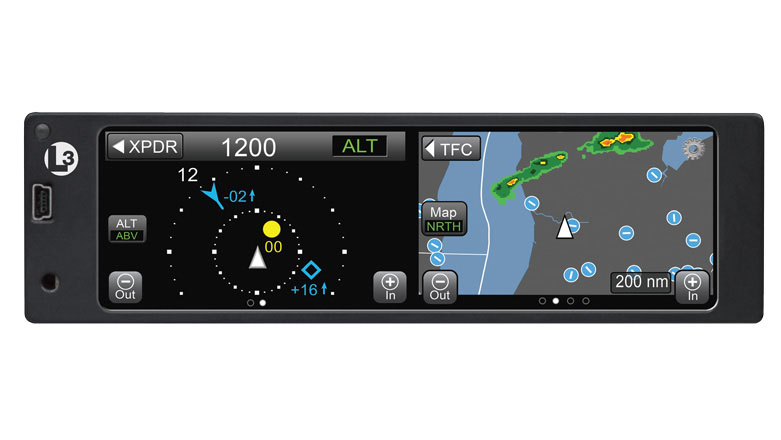Find the right display for ADS-B information
So far in this series we have covered options for choosing an Automatic Dependent Surveillance-Broadcast (ADS-B) system based on what it puts Out and what it receives In. Now it’s time to select a solution based on the fun part: How will the information be displayed?

There are many options for displaying ADS-B traffic and weather data in your cockpit. You can display the information on a tablet, on a GPS/MFD, on a glass panel PFD and, in the case of the L-3 Lynx, even on the transponder itself. It all depends on what you already have installed in your aircraft, your budget, and how far you want to take your aircraft’s panel.
Traffic Display
Traffic is the most basic output product of an ADS-B receiver. Most systems output traffic data in two ways: The old traffic data format (TIS) can be displayed on almost any legacy display such as a Garmin 430. This traffic is usually displayed as diamonds with arrows for altitude trends. The new ADS-B traffic format has a lot more information to offer the pilot. Traffic is displayed as directional arrowheads and can include vector lines depicting the track and speed of the aircraft. Traffic also is color-coded to indicate proximity and converging paths of flight. And, you can even see information about the target aircraft such as altitude, aircraft ID, and aircraft make/model.
If you want to have the benefit of the new ADS-B traffic display functionality, you will need to select a display and ADS-B receiver that work together. That’s not as easy as it sounds, and sometimes requires that both the display and the receiver be the same brand. Fortunately, that situation has been improving recently with many of the avionics companies sharing their data formats.
Aspen Avionics has been at the forefront of compatibility since the company introduced its Evolution PFDs and MFDs. Recent updates from Aspen make it possible to display ADS-B traffic and weather from a variety of other companies’ ADS-B units, in addition to Aspen’s own ADS-B products. An additional benefit of using Aspen’s PFD for traffic display is that traffic also can be shown in 3-D through Aspen’s Synthetic Vision technology. This makes it much easier to correlate the traffic on your panel with the traffic search out your window because you know exactly where to look.
Weather Display
Unlike traffic, the display of FIS-B weather only works if the receiver and the display are designed to work together. There is no “old standard” that can be used as there is with traffic. The avionics either play well together, or not at all.
This is where tablet displays come to the rescue. Even if the displays in your panel are not compatible with the weather display from your chosen ADS-B receiver, many receivers, including some of the low-cost ADS-B units from L-3 and FreeFlight Systems, have built-in Wi-Fi to display weather (and traffic) on an iPad. It can be a great solution for those on a budget, as well as for those waiting for software updates to their panel-mount displays to become compatible with receivers from other companies. (Keep in mind that most of the lowest-priced ADS-B units are Out only; be sure your selection supports In if you want that capability. The Wi-Fi module might be an option with an accompanying upcharge.)
One of the important factors to consider when selecting how you will display your new ADS-B data is “information overload.” Putting all of your data in one place can make it difficult to discern the most critical information from less-relevant information. For example, displaying navigation, terrain, weather, and traffic information on a single GPS navigator screen is possible, but is it wise?
This is where having multiple displays works to your advantage. If you have a PFD, you can use it to display the most important tactical information such as your course and local traffic. In this design, your GPS/MFD can be used for navigation and weather strategy. If you don’t have a PFD, your GPS/MFD becomes your tactical display, and your tablet can be used for weather strategy. The key is to prevent information overload and make the most critical information easy to see.
If you want the ultimate in display flexibility, you may want to consider the Lynx 9000 from L-3 as your ADS-B solution. This is because the Lynx is the only ADS-B solution currently on the market that has a built-in touchscreen display for weather and traffic (in addition to its transponder functions). For this reason, many users who choose to toss their old transponder and upgrade to the Lynx choose to re-order their radio stack, putting the transponder at the top of the stack, just below the audio panel. The Lynx also has options for terrain display, making it possible to use it as a dedicated all-in-one hazard display while still maintaining the option to selectively display weather and traffic on many GPS, MFD, or PFD screens. The bottom line is that you can experiment with what configuration works best for you, increasing situational awareness without data overload.
There are many options to consider when developing your ADS-B traffic and weather strategy, but hopefully this helps. Next time, we will talk about installation considerations. Until then, happy flying!

